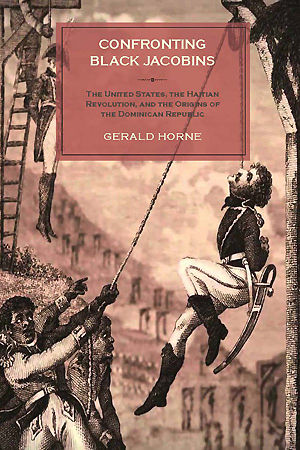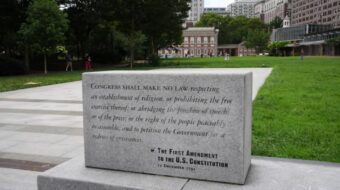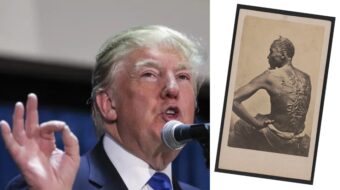
In the introduction to his book, Confronting Black Jacobins, Gerald Horne writes that the 1804 Haitian Revolution “was so profound, so important, so stunning, that it may require an entire school of historians to take its true measure.” Arguably, he adds, this revolution – an affront to both slavery and white supremacy, bolstering revolt throughout the slave South – changed the course of history.
Horne, who holds the John J. and Rebecca Moores Chair of History and African American Studies at the University of Houston, articulates a number of themes throughout his books, primarily the role of external, international powers in the centuries-long struggle led by African Americans for freedom and equality.
Confronting Black Jacobins builds on Horne’s prior work – namely, Negro Comrades of the Crown. In Jacobins, he demonstrates through copious amounts of documentation and research the impact external, international forces had on slave resistance within the “slave-holding republic,” the frightened slave owners’ response to this external threat and the ever-evolving U.S. policy towards Haiti, the first Black republic.
As the title suggests, Jacobins puts the Haitian Revolution into a larger political context. The former slaves – on what would soon become the first Black republic – saw themselves as revolutionaries continuing the democratic upsurge initiated by the radical Jacobins in France.
While slavery was expanding in the former colonies, and while Great Britain was moving towards abolition – readily making overtures to Blacks in the former colonies, offering arms if they would wear Redcoats – what was soon to become Haiti was in the throes of revolt. Astutely sensing that its northern neighbor had other priorities – foremost, the defense of slavery on the mainland – the Black Jacobins dealt a body blow to their former masters and white supremacy generally by rising-up and exacting bloody revenge, a lesson Southern slave owners were slow to learn.
As Horne writes, “The vaunted Founding Fathers then administering the slave-holding republic seemed incapable of comprehending the world historic forces that were being unloosed at that time,” an event undoubtedly comprehended by the enslaved themselves – as evidenced by the steady increased of slave revolts, plots and plans, as well as the on-going chatter about Haitian designs on St. Domingo, thereby literally extending the reach of the Black Republic geographically.
As a contemporary noted in 1824 regarding the Haitian revolt, “human blood was poured forth in torrents” as thousands of slave owners, their families and children were killed, a future Southern plantation owners were desperately trying to avoid. “Literate mainland observers may have been excused if they thought the official name of Haiti – or Hayti – was ‘horrors,'” Horne added.
“The wider point,” he continued, “is that [Thomas] Jefferson’s dystopian fear of Africans taking control of the Caribbean as a prelude to a wider hemispheric domination did not seem like fantasy in the early 19th century.”
“To be sure, there was nervous apprehension about continuing the African slave trade [by some] on the mainland. However,” Horne continued, “like hopelessly hooked addicts, the presumed euphoric profits were too extravagant to reject.” So the horrific trade in human flesh continued.
Ironically, by 1819 Haiti was becoming a major trading partner with the U.S. Emerging industrial interests in the North, along with a growing abolitionist sentiment, wanted “trade with the island of freedom thereby offend[ing] Dixie and quicken[ing] sectional conflict that eventuated in civil war.”
Further, for example, from 1824 to 1826 “at least 6000 Free Negroes” left the mainland. “There was push and pull involved” in this migration, Horne notes.
“Free Negroes were viewed suspiciously for fear that they would join with the enslaved in a mainland version of the Haitian Revolution and getting rid of them by any means necessary was a priority” to white elites, hence the push. “The ‘pull,’ in short, was embodied in residing in a sovereign African republic, as opposed to a slave-holding republic” and experiencing first-hand the freedom denied their enslaved brethren.
Complicating matters was Great Britain’s move towards abolition, especially in its Caribbean colonies. London found its empire stretched too thin, and rationalized that freeing and arming Caribbean’s of African descent was the better of numerous bad options. Armed Blacks in Redcoats could then act as a bulwark against Dixie’s expansionists’ plans, a very real threat to London.
For, at this time Southern slave owners realistically dreamed of not only expanding west – which proved more tangible and pragmatic, at least temporarily – but also south into the Caribbean and Latin America. As James Gadsden – Florida planter, army general and murderer of Seminole Indians -opined, “Have you ever in your visions, dreamt of a great federation of West Indian islands, stimulated in their prosperity and advancement by African slavery as now existing in the Southern States? History has never recorded such a commercial and naval power as Cuba, St. Domingo, Potro Rico [sic], and Jamaica united under one Confederation…,” a slave-holding confederation.
Tellingly, Gadsden shared his wretched plans for slavery’s expansion with Jefferson Davis, the future president of the Confederate States.
Jacobins can be summed-up thusly: for decades following independence the U.S. sought “to re-enslave the entire island and liquidate independence…,” as “…the revolutionary example of Haiti spread throughout the Americas and created a general crisis of the slave system that could only be resolved – thankfully – with its collapse. As a result, Africans in particular and the international working class in general owe a massive debt of gratitude to the Black Jacobins…,” Horne concludes.
Confronting Black Jacobins is a tour de force. Gerald Horne, like the events he writes about, is arguably redefining the historical profession, building a narrative of Black Liberation no serious student of history should ignore.
Confronting Black Jacobins: The United States, The Haitian Revolution, And The Origins Of The Dominican Republic
By Gerald Horne
Monthly Review Press, 2015, 423 pages
Available in hardcover, paperback and Kindle editions










